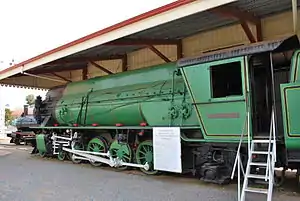Silverton Tramway W class
The Silverton Tramway W class was a class of 4-8-2 steam locomotives operated by the Silverton Tramway Company.
| Silverton Tramway W class | |||||||||||||||||||||||||||||||
|---|---|---|---|---|---|---|---|---|---|---|---|---|---|---|---|---|---|---|---|---|---|---|---|---|---|---|---|---|---|---|---|
 W24 Malcolm Moore at Sulphide Street Museum in August 2009 | |||||||||||||||||||||||||||||||
| |||||||||||||||||||||||||||||||
| |||||||||||||||||||||||||||||||
| |||||||||||||||||||||||||||||||
| |||||||||||||||||||||||||||||||
History
In January 1949, the Silverton Tramway Company ordered two 4-8-2 locomotives from Beyer, Peacock & Co, Manchester, to the same design as the Western Australian Government Railways W class. A further two were ordered in November 1950.[1][2]
All four arrived at Port Pirie in October 1951 and, after final assembly, moved to Broken Hill in a convoy, with two in steam. Until 1953, all were hired to the South Australian Railways on a rotating basis, operating services out of Peterborough, until the South Australian Railways 400 class locomotives were delivered.[2][3]
The Silverton W class differed from the WAGR examples in having a skyline cowling running the length of the boiler and smokebox, Westinghouse air brakes, and an additional blow-down valve in the middle of the bottom of the boiler barrel.[1][2][3]
When the 48s class diesels arrived in 1961, the W class locomotives were retired, after only 10 years in service. They remained in store until disposed of in 1970, with three now preserved. The Pichi Richi Railway has a locomotive operating as W22, although it is actually W916 masquerading as W22, including some parts from the latter.[2][4]
Class list
|
References
- Gunzburg, Adrian (1984). A History of WAGR Steam Locomotives. Perth: Australian Railway Historical Society. p. 136. ISBN 0 9599690 3 9.
- Oberg, Leon (2010). Locomotives of Australia 1850s-2010. Dural: Rosenberg Publishing. pp. 251–253. ISBN 9781921719011.
- McNicol, Steve (1981). Silverton Tramway Locomotives. Elizabeth Downs: Railmac Publications. pp. 17/18. ISBN 0 959415 30 0.
- W22 Australian Steam
- Trial runs of steam locomotive W22 Justin Hancock Pichi Richi Railway 6 April 2003
- W24 Australian Steam
- HF (Gerry) Walsh National Railway Museum
- W25 Australian Steam